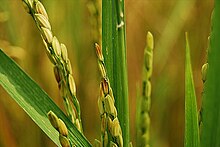
Practicing Citations edit
- Rice suggests a decline in seasonal drought, with early season rice (early rice hereafter) by 12,500 km2, middle season rice (middle rice) by 80,000 km2, and in particular late season rice (late rice) by 25,000 km2, which accounts for almost 20% of its cultivated acreage. [1]
- Southern China was the genetic diversity centre of O. rufipogon, and the Pearl River basin near the Tropic of Cancer was the domestication centre of O. sativa in China. [2]
- A wide range of genetic and archaeological studies have been carried out to examine the phylogenetic relationships of rice, and investigate the demographic history of rice domestication. [3]
- A number of new genetic materials with idiotype have been created successfully, and the Ministry of Agriculture of China has approved 156 novel super rice varieties and combinations for commercialisation. [4]
- Evidence for very early rice cultivation in the region may mesh with another find described at the meeting: a walled city several hundred kilometres upstream that could be the oldest such settlement yet found in China. [5]
Answers to Module 7 Questions edit
- A picture of Salmon Bowl with drinks at a brunch.
- It is my own work
- File Format is original file in a PDF file format
- The license chosen is Creative Commons Attribution-Share Alike 4.0 International license
- Food, Salmon, Salmon Bowl, Brunch, Latte, Rice
- English: Salmon Bowl with a matcha latte
References edit
- ^ Ma, Xin; Wu, Shaohong; Li, Yu’e; Zhang, Xueyan; Gao, Qingzhu; Wu, Yang (2013-01-12). "Rice re-cultivation in southern China: An option for enhanced climate change resilience in rice production". Journal of Geographical Sciences. 23 (1): 67–84. doi:10.1007/s11442-013-0994-x. ISSN 1009-637X.
- ^ Wei, Xin; Qiao, Wei-Hua; Chen, You-Tao; Wang, Rong-Sheng; Cao, Li-Rong; Zhang, Wan-Xia; Yuan, Nan-Nan; Li, Zi-Chao; Zeng, Han-Lai; Yang, Qing-Wen (2012-09-18). "Domestication and geographic origin ofOryza sativain China: insights from multilocus analysis of nucleotide variation ofO. sativaandO. rufipogon". Molecular Ecology. 21 (20): 5073–5087. doi:10.1111/j.1365-294x.2012.05748.x. ISSN 0962-1083.
{{cite journal}}: no-break space character in|title=at position 123 (help) - ^ Huang, Xuehui; Kurata, Nori; Wei, Xinghua; Wang, Zi-Xuan; Wang, Ahong; Zhao, Qiang; Zhao, Yan; Liu, Kunyan; Lu, Hengyun; Li, Wenjun; Guo, Yunli (2012-10). "A map of rice genome variation reveals the origin of cultivated rice". Nature. 490 (7421): 497–501. doi:10.1038/nature11532. ISSN 1476-4687.
{{cite journal}}: Check date values in:|date=(help) - ^ TANG, Liang; XU, Zheng-jin; CHEN, Wen-fu (2017-05). "Advances and prospects of super rice breeding in China". Journal of Integrative Agriculture. 16 (5): 984–991. doi:10.1016/s2095-3119(16)61604-0. ISSN 2095-3119.
{{cite journal}}: Check date values in:|date=(help) - ^ Normile, Dennis (1997-01-17). "Yangtze Seen as Earliest Rice Site". Science. 275 (5298): 309–309. doi:10.1126/science.275.5298.309. ISSN 0036-8075.